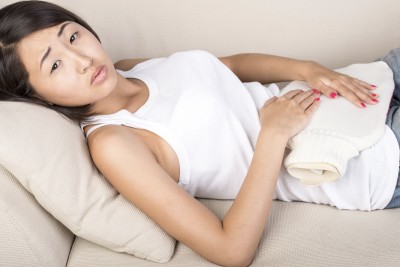 Menstruation, or period, is the shedding of a woman’s uterus lining. Each month, one of the ovaries releases an egg. This is called ovulation. At the same time, hormonal changes prepare the uterus for pregnancy. If ovulation takes place and the egg is not fertilized, the lining of the uterus sheds through the vagina and passes out the body (this is the blood that you see). Menstruation is part of the menstrual cycle. A cycle is counted from the first day of one period to the first day of the next period. The average menstrual cycle is 28 days long. If a woman does not have a period for 90 days, she should see the doctor to check for pregnancy, early menopause, or other medical problems.
Menstruation, or period, is the shedding of a woman’s uterus lining. Each month, one of the ovaries releases an egg. This is called ovulation. At the same time, hormonal changes prepare the uterus for pregnancy. If ovulation takes place and the egg is not fertilized, the lining of the uterus sheds through the vagina and passes out the body (this is the blood that you see). Menstruation is part of the menstrual cycle. A cycle is counted from the first day of one period to the first day of the next period. The average menstrual cycle is 28 days long. If a woman does not have a period for 90 days, she should see the doctor to check for pregnancy, early menopause, or other medical problems.
On an average, girls get their first menstrual period between 8-13 years old. The first menstrual period typically starts two to two-and-a-half years after breast development begins. Periods can be light, moderate, or heavy, and the length of the period also varies from woman to woman. Most periods last from 3 to 5 days. During the early years of menstruation, girls usually have “medium” menstrual flow; most report changing a pad approximately 3 to 6 times a day.
During menstruation, the uterus, which is a muscle, contracts and relaxes more than it does at other times in the month. This can produce the uncomfortable feeling of cramps. Using a heating pad or hot water bottle may help ease some of the discomfort. Taking over-the-counter pain relievers such as naproxen, ibuprofen, or acetaminophen may also help. Do not take aspirin, as aspirin usage has been linked to a deadly disease known as Reye’s syndrome in children and teenagers. Reye’s syndrome affects all organs of the body, specially the liver and brain. Other discomforts during menstruation include breast tenderness, bloating, headaches, fatigue, mood swings, and food cravings. Some women will experience these symptoms more than others, and not every woman will experience all of these symptoms.
You should track your period on a calendar to have some idea of when it will start. Remember to carry a few pads with you to school or work a day or two before your period is due to begin. You should also keep sanitary products in stock at home.
Menstrual Products
Pads
Menstrual pads are disposable rectangular pieces of material that attach to the insides of underwear to absorb menstrual flow. Pads often come with adhesive backings and “wings” (extra material on the sides that fold around the underwear) to hold them in place.
The shape, absorbency, and lengths may vary depending on the manufacturer, but there are several different types of menstrual pads:
- Panty liner: Designed to absorb very light menstrual flow or vaginal discharge.
- Ultra-thin: Very thin pad, which may be as absorbent as regular pad but less bulky.
- Regular: Middle range absorbency.
- Maxi/ Super: Larger absorbency, useful for the start for the menstrual cycle when menstruation is often the heaviest.
- Night: A longer pad to allow for more protection while the wearer is lying down, with absorbency suitable for overnight use.
- While some pads are labeled fragrance-free, others may come with light deodorant to cover any menstrual odor, but deodorizing substance may cause irritation in some women.
Tampons
Unlike pads, which are worn externally, tampons are cylindrical material to be inserted into the vagina to absorb blood. Each tampon has a string attached to one end for ease of removal, and may be packaged inside an applicator (a plastic or cardboard tube) to aid insertion. Tampons also come in different absorbency ratings.
Keep Clean
Remember to wash your hands before and after using a pad or tampon. It is also very important that you change the pad or tampon at least every 4-6 hours and avoid tampon usage over night. Leaving a tampon in the body longer than recommended increases the risk of toxic shock syndrome (TSS), a rare but potentially fatal disease caused by bacterial infection. Symptoms of TSS include high fever, vomiting, diarrhea, extreme weakness, diffuse rash, and others. Seek medical advice immediately if needed. However, TSS is very rare. Most women never become ill from using tampons, especially if they change tampons regularly.

